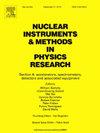Particle identification in high-granularity 3D calorimeters for space-borne applications
IF 1.5
3区 物理与天体物理
Q3 INSTRUMENTS & INSTRUMENTATION
Nuclear Instruments & Methods in Physics Research Section A-accelerators Spectrometers Detectors and Associated Equipment
Pub Date : 2024-11-14
DOI:10.1016/j.nima.2024.170063
引用次数: 0
Abstract
High granularity 3D calorimeters offer the potential to precisely reconstruct the 3D topology of electromagnetic and hadronic showers originating from isotropic sources. This distinctive capability creates the opportunity for applying reconstruction and analysis methods that could yield additional information compared to those based on the traditional layer-by-layer energy deposit analysis common in particle and astroparticle physics experiments utilizing calorimeters with layer segmentation. In this study, we present a strategy for analyzing the energy deposit in a crystal array calorimeter, utilizing the 3D parametrization of both longitudinal and transversal shapes of showers to implement likelihood tests on single events. While this analysis was developed using the High Energy cosmic Radiation Detector (HERD) calorimeter as a case study, its applicability may extend to any high granularity, homogeneous, isotropic calorimeter employed in particle physics experiments.
空间应用高粒度三维量热仪中的粒子识别
高粒度三维热量计为精确重建来自各向同性源的电磁和强子簇的三维拓扑结构提供了可能。这种与众不同的能力为应用重建和分析方法创造了机会,与粒子和天体粒子物理实验中常见的基于传统的逐层能量沉积分析方法相比,这些方法可以产生更多的信息。在本研究中,我们提出了一种分析晶体阵列量热计中能量沉积的策略,利用阵列纵向和横向形状的三维参数化对单个事件进行似然测试。虽然该分析是以高能宇宙辐射探测器(HERD)量热仪为案例开发的,但其适用性可扩展到粒子物理实验中使用的任何高粒度、均质、各向同性量热仪。
本文章由计算机程序翻译,如有差异,请以英文原文为准。
求助全文
约1分钟内获得全文
求助全文
来源期刊
CiteScore
3.20
自引率
21.40%
发文量
787
审稿时长
1 months
期刊介绍:
Section A of Nuclear Instruments and Methods in Physics Research publishes papers on design, manufacturing and performance of scientific instruments with an emphasis on large scale facilities. This includes the development of particle accelerators, ion sources, beam transport systems and target arrangements as well as the use of secondary phenomena such as synchrotron radiation and free electron lasers. It also includes all types of instrumentation for the detection and spectrometry of radiations from high energy processes and nuclear decays, as well as instrumentation for experiments at nuclear reactors. Specialized electronics for nuclear and other types of spectrometry as well as computerization of measurements and control systems in this area also find their place in the A section.
Theoretical as well as experimental papers are accepted.

 求助内容:
求助内容: 应助结果提醒方式:
应助结果提醒方式:


